学习情态动词应该注意的几个问题
文档属性
| 名称 | 学习情态动词应该注意的几个问题 | 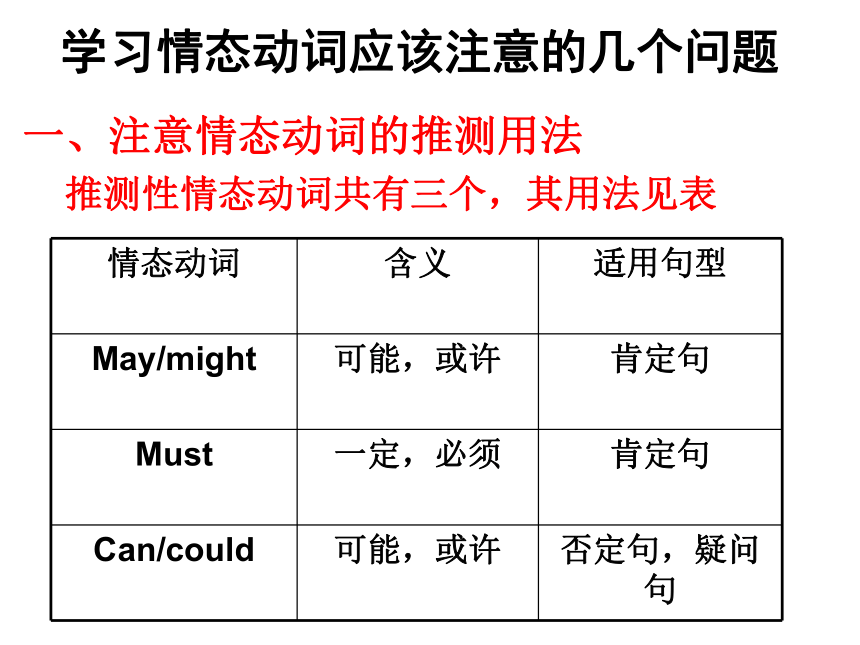 | |
| 格式 | rar | ||
| 文件大小 | 125.9KB | ||
| 资源类型 | 教案 | ||
| 版本资源 | 人教版(新课程标准) | ||
| 科目 | 英语 | ||
| 更新时间 | 2008-07-05 22:52:00 | ||
图片预览

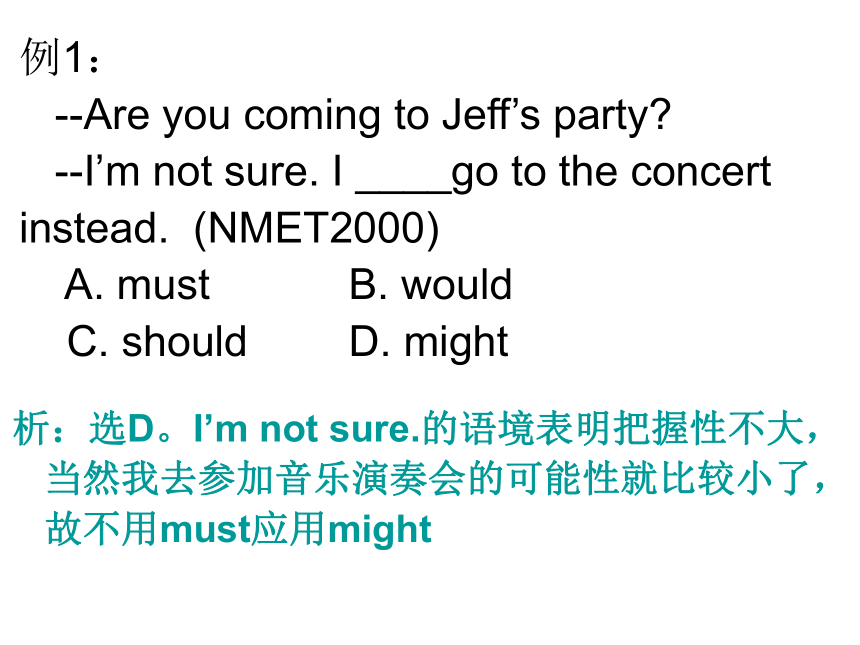
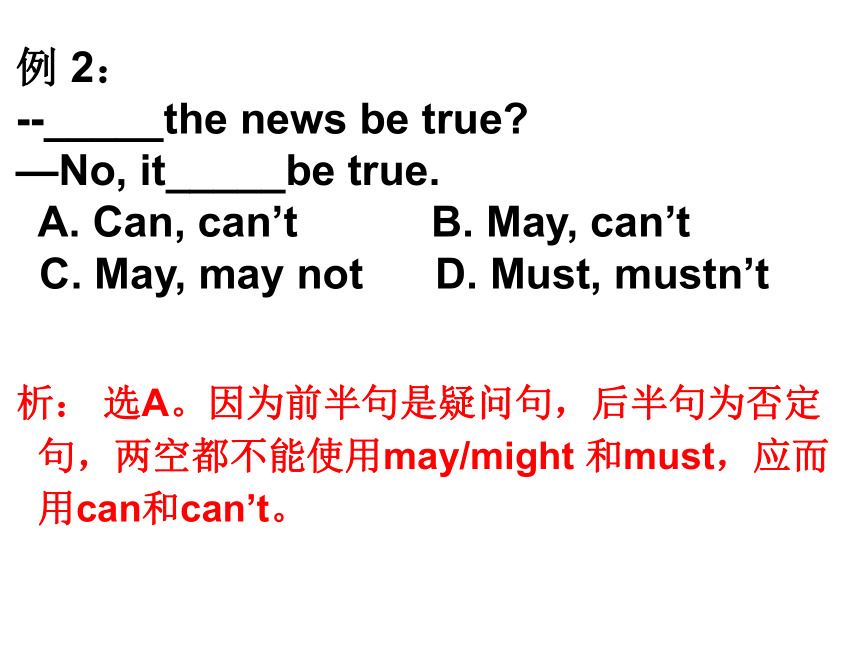
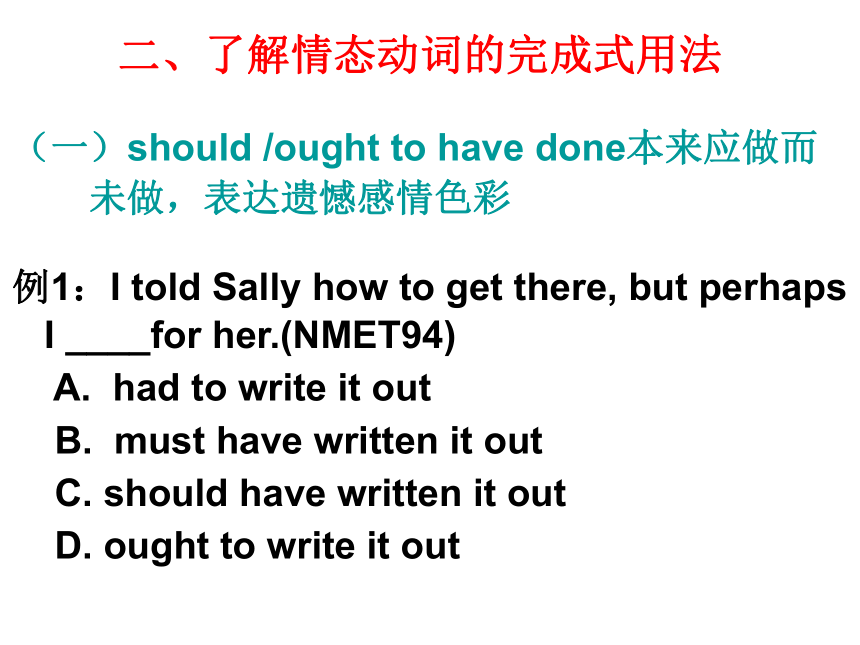
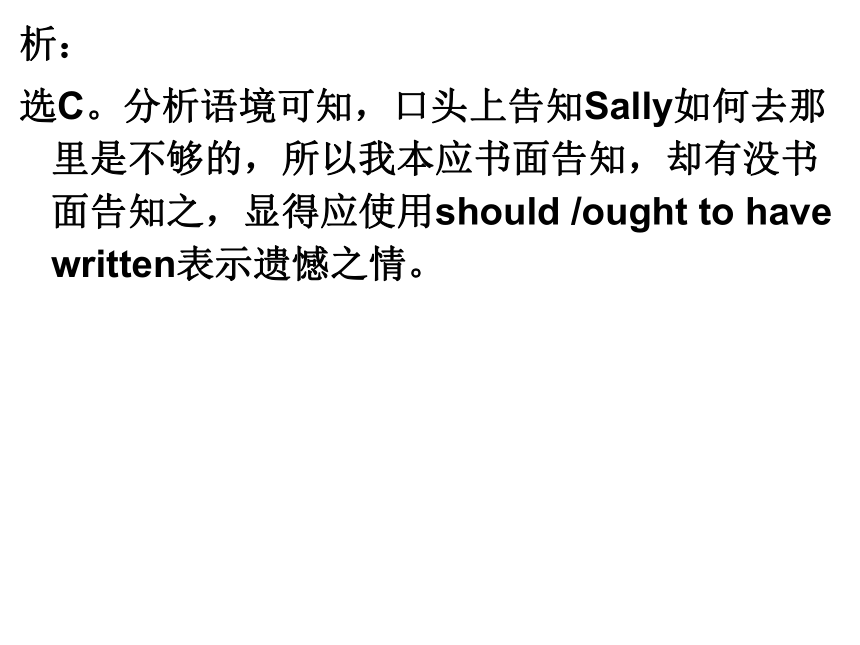


文档简介
课件19张PPT。学习情态动词应该注意的几个问题一、注意情态动词的推测用法
推测性情态动词共有三个,其用法见表 例1: --Are you coming to Jeff’s party? --I’m not sure. I ____go to the concert instead. (NMET2000) A. must B. would C. should D. might析:选D。I’m not sure.的语境表明把握性不大,当然我去参加音乐演奏会的可能性就比较小了,故不用must应用might例 2: --_____the news be true? —No, it_____be true. A. Can, can’t B. May, can’t C. May, may not D. Must, mustn’t 析: 选A。因为前半句是疑问句,后半句为否定句,两空都不能使用may/might 和must,应而用can和can’t。二、了解情态动词的完成式用法(一)should /ought to have done本来应做而未做,表达遗憾感彩
例1:I told Sally how to get there, but perhaps I ____for her.(NMET94)
A. had to write it out
B. must have written it out
C. should have written it out
D. ought to write it out析:
选C。分析语境可知,口头上告知Sally如何去那里是不够的,所以我本应书面告知,却有没书面告知之,显得应使用should /ought to have written表示遗憾之情。例2:
I was really anxious about you, you _____home without a word.(NMET2001)
A. mustn’t leave B. shouldn’t have left
C. couldn’t have left D. needn’t leave 析: 选B。
由语境可知,我真的为你担心,所以你不应该一句话不说就离开家,但实际上你确实这么做了,显然应填shouldn’t/ought to have left,表示责备。 (二)may/might have done可能已做 must have done 一定已做 can’t have done不可能做例1:--Where is my pen?
-- I _____it.(NMET88)
A. might lose B. wouldn’t have lost
C. should have lost D. must have lost例2: The light in his room is still on, so he _____ to bed. A. mustn’t have gone B. must have gone C. shouldn’t have gone D. can’t have gone析:选D。由于他房间里的灯还亮着推测,他不可能已经上床睡觉了,应填can’t have gone 。(三)could have done指本来能做而实际未做,表达遗憾的感彩 You could at least have sent five cards.
你至少可以寄5张明信片的。三、熟悉情态动词委婉用法:
could, would, might等情态动词均有委婉用法,它们不是过去式而是表示语气委婉、客气、礼貌,常用与疑问句,并多用于习惯表达, 如would you please, would you mind, would you like to等,might还可以用于肯定句表示推测,表示可能性小, might和could表示征求对方意见时,回答必须还成may, can.例1:--Could I borrow your dictionary?—Yes, of course you____. A. might B. will C. can D. should析:选C。该句用can的委婉表达式could 来征求对方意见,could 和might通用,但回答时必须还成can或may,因此该题不选A.例2:____you mind my smoking here? A. Should B Could C. Might D. Would析:选D。征求对方意见我是否在这儿吸烟,语气理应委婉,所以应选委婉的表达方式would you mind…来征求对方意见。四、弄清情态动词的异化现象 有些情态动词用于疑问句进行回答时,出现了异化现象,此时回答在某个角度不能继续使用该情态动词, 而改用别的情态动词。 例1:--Must I start at once? —No, you____. A. needn’t B. mustn’t C. can’t D. won’t析:A。由语境可知该答句表示“不必”,而mustn’t表示“不准、禁止”,不符合语境,显然应使用needn’t 表示“不必”,但肯定句回答继续用must。例2:--Need I hand in my exercise book at once? —Yes, you_____. A. must B. need C. can D. will析:选A。根据规定need用于一般疑问句作肯定回答应换成must,而作否定回答时,使用need的否定式needn’t。五、掌握征求意见情态动词的回答 不少情态动词可用于疑问句征求对方意见,但人称上有时有特殊要求,请看下表: 例1: --_____I tell John about it? --No, you needn’t. I have told him already. (NMET94) A. Shall B. Will C. Can D. May析:选A。从回答句“No, you needn’t”的语境可知,问句征求对方意见,表示“需要”而且用语第一人称,要使用shall。例2:_____you please help me with my English? A. Would B. Do C. Shall D. Can析:A。次句表示追求对方意见,有“愿意 ”之意,而且又用于地二人称,应选用would。典型错误1. He mustn’t be in the classroom. ( )can’t2. You might leave the bag on the bag.
( )might have left3. You must have seen the film last week, haven’t you? ( )didn’t you 4. Li ming must have been to Japan, didn’t he?
( )hasn’t he
推测性情态动词共有三个,其用法见表 例1: --Are you coming to Jeff’s party? --I’m not sure. I ____go to the concert instead. (NMET2000) A. must B. would C. should D. might析:选D。I’m not sure.的语境表明把握性不大,当然我去参加音乐演奏会的可能性就比较小了,故不用must应用might例 2: --_____the news be true? —No, it_____be true. A. Can, can’t B. May, can’t C. May, may not D. Must, mustn’t 析: 选A。因为前半句是疑问句,后半句为否定句,两空都不能使用may/might 和must,应而用can和can’t。二、了解情态动词的完成式用法(一)should /ought to have done本来应做而未做,表达遗憾感彩
例1:I told Sally how to get there, but perhaps I ____for her.(NMET94)
A. had to write it out
B. must have written it out
C. should have written it out
D. ought to write it out析:
选C。分析语境可知,口头上告知Sally如何去那里是不够的,所以我本应书面告知,却有没书面告知之,显得应使用should /ought to have written表示遗憾之情。例2:
I was really anxious about you, you _____home without a word.(NMET2001)
A. mustn’t leave B. shouldn’t have left
C. couldn’t have left D. needn’t leave 析: 选B。
由语境可知,我真的为你担心,所以你不应该一句话不说就离开家,但实际上你确实这么做了,显然应填shouldn’t/ought to have left,表示责备。 (二)may/might have done可能已做 must have done 一定已做 can’t have done不可能做例1:--Where is my pen?
-- I _____it.(NMET88)
A. might lose B. wouldn’t have lost
C. should have lost D. must have lost例2: The light in his room is still on, so he _____ to bed. A. mustn’t have gone B. must have gone C. shouldn’t have gone D. can’t have gone析:选D。由于他房间里的灯还亮着推测,他不可能已经上床睡觉了,应填can’t have gone 。(三)could have done指本来能做而实际未做,表达遗憾的感彩 You could at least have sent five cards.
你至少可以寄5张明信片的。三、熟悉情态动词委婉用法:
could, would, might等情态动词均有委婉用法,它们不是过去式而是表示语气委婉、客气、礼貌,常用与疑问句,并多用于习惯表达, 如would you please, would you mind, would you like to等,might还可以用于肯定句表示推测,表示可能性小, might和could表示征求对方意见时,回答必须还成may, can.例1:--Could I borrow your dictionary?—Yes, of course you____. A. might B. will C. can D. should析:选C。该句用can的委婉表达式could 来征求对方意见,could 和might通用,但回答时必须还成can或may,因此该题不选A.例2:____you mind my smoking here? A. Should B Could C. Might D. Would析:选D。征求对方意见我是否在这儿吸烟,语气理应委婉,所以应选委婉的表达方式would you mind…来征求对方意见。四、弄清情态动词的异化现象 有些情态动词用于疑问句进行回答时,出现了异化现象,此时回答在某个角度不能继续使用该情态动词, 而改用别的情态动词。 例1:--Must I start at once? —No, you____. A. needn’t B. mustn’t C. can’t D. won’t析:A。由语境可知该答句表示“不必”,而mustn’t表示“不准、禁止”,不符合语境,显然应使用needn’t 表示“不必”,但肯定句回答继续用must。例2:--Need I hand in my exercise book at once? —Yes, you_____. A. must B. need C. can D. will析:选A。根据规定need用于一般疑问句作肯定回答应换成must,而作否定回答时,使用need的否定式needn’t。五、掌握征求意见情态动词的回答 不少情态动词可用于疑问句征求对方意见,但人称上有时有特殊要求,请看下表: 例1: --_____I tell John about it? --No, you needn’t. I have told him already. (NMET94) A. Shall B. Will C. Can D. May析:选A。从回答句“No, you needn’t”的语境可知,问句征求对方意见,表示“需要”而且用语第一人称,要使用shall。例2:_____you please help me with my English? A. Would B. Do C. Shall D. Can析:A。次句表示追求对方意见,有“愿意 ”之意,而且又用于地二人称,应选用would。典型错误1. He mustn’t be in the classroom. ( )can’t2. You might leave the bag on the bag.
( )might have left3. You must have seen the film last week, haven’t you? ( )didn’t you 4. Li ming must have been to Japan, didn’t he?
( )hasn’t he
